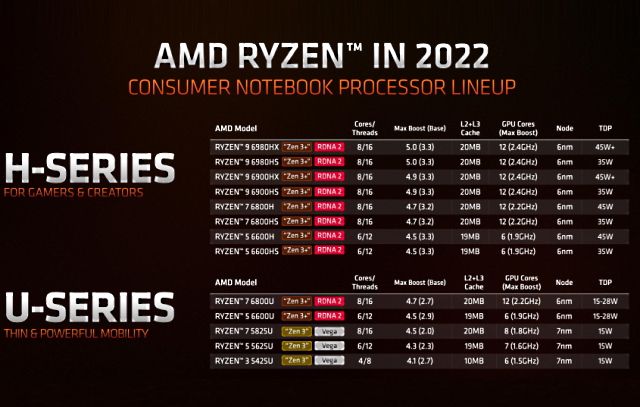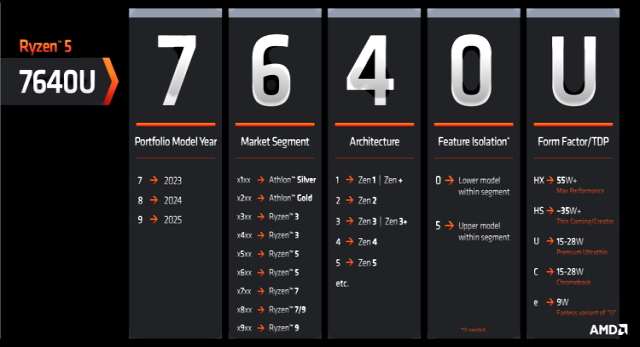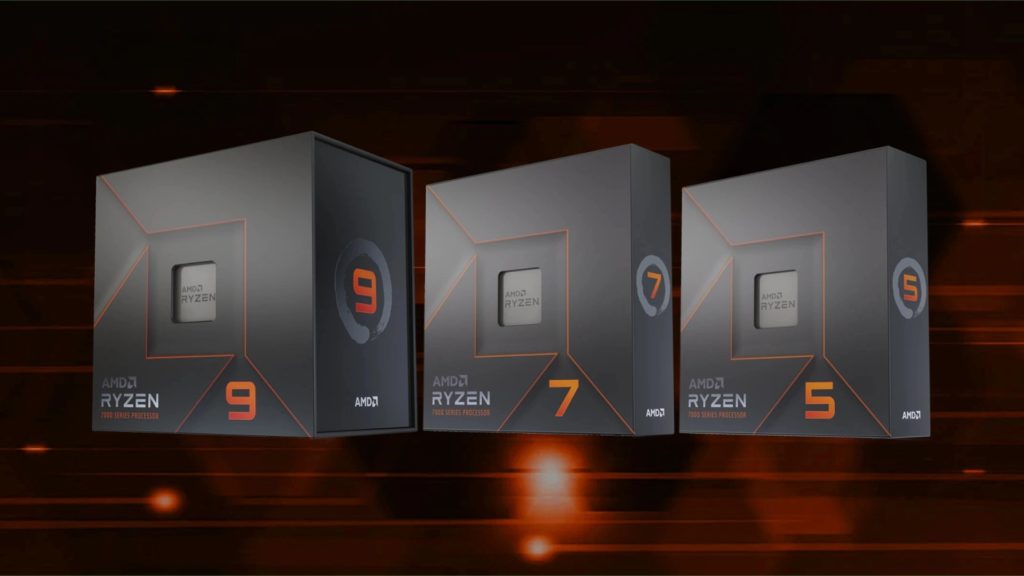Decoding mobile processor names can be quite confusing going by just the combination of numbers and letters assigned to it. This applies to both AMD and Intel, I mean what’s the difference between a Ryzen 5900HX and a Ryzen 6900X? In a bid to make it easier for consumers, AMD has revealed a new naming nomenclature for its 2023 Ryzen mobile processors.
The new naming guideline from AMD is meant to replace the current processor naming scheme. Before we get to the newly released naming scheme let’s first take a moment and understand AMD’s current naming scheme.
The Current AMD Naming Scheme – 2022 and Before
For this, we will choose one of the latest 2022 chips from AMD and use it to deconstruct the current naming system, the Ryzen 9 6980HX.
- Here, the first part, Ryzen 9 stands for the processor category in AMD’s hierarchy. AMD basically has four categories: Ryzen 3, Ryzen 5, Ryzen 7, and Ryzen 9. These categories can be likened to Intel’s Core i3, Core i5, and Core i7.
- The “6” denotes the generation of the processor, for our case example it will be the 6th generation. This is why this chip can be referred to as a Ryzen 6000 series chip.
- The “9” is meant to position the processor relative to other similar generation Ryzen 9 chips. For instance, a 6980HX should be more powerful than a 6920HX chip.
- The last two numbers “8” & “0” are differentiators which are “00” most of the time or a multiple of 5 or 10. This is what they use to distinguish between mainstream and professional processors. The last number in this pair can also be used to show power consumption. A good example is Ryzen 7 PRO 5875U where the last “5” denotes ultra-low power consumption.
- The letters at the end are supposed to tell the power class of the mobile processor. For example, U means ultra-portable with 15-28W power consumption. H stands for high-power mobile with power consumption between 35W and 45W. HX is for high-performance mobile chips with high power requirements of 55W and with overclocking abilities.

Also Read:
- CPU Overclocking: Base Clock and Multiplier Overclocking Explained
- AMD Ryzen processor family: Everything you need to know
Hold On, There’s More!
To simplify, or complicate further, the H chips are designed for mainstream power laptops, gaming laptops, and workstations. These come with discrete graphics cards. The U chips are designed for very light notebooks that depend on integrated graphics. Now, let us get into the intriguing part. As it stands, AMD has six processor generations. A normal person would think, Ryzen 1000 all the way to Ryzen 6000, but AMD thought otherwise. They started with Ryzen 2000, had two Ryzen 5000s and that’s how we are at Ryzen 6000. I hope the table below helps.
| Gen | Series/Generation | Micro-Architecture | Example |
| First Gen | Ryzen 2000 Series | Zen | Ryzen 2800H |
| Second Gen | Ryzen 3000 Series | Zen+ | Ryzen 7 3750H |
| Third Gen | Ryzen 4000 Series | Zen 2 | Ryzen 7 4800H |
| Third Gen | Ryzen 5000 Series | Zen 2 | Ryzen 7 5700U |
| Fourth Gen | Ryzen 5000 Series | Zen 3 | Ryzen 7 5800H |
| Fifth Gen | Ryzen 6000 Series | Zen 3+ | Ryzen 9 6980HX |
In light of the above complications in decoding what a certain AMD processor is, AMD is moving to a new naming scheme that is intended to be straightforward. And should also accommodate new products that are in development.
“Our current naming system for Ryzen Mobile Processors was at an end. It simply could not accommodate the influx of new SOCs in new categories we’re developing.“ Robert Hallock, AMD’s director of technical marketing
Advertisement - Continue reading below
Also Read:
- How to interpret Intel processor brand names (e.g. 8th Gen Intel® Core™ i7-8700K)
- Intel CPU Brand Letters & Nomenclature Explained
AMD’s New Naming Scheme – 2023 and Beyond
The new AMD naming scheme will be used starting with the 7000 series chips due in 2023 which will come with five different SoCs. The five SoCs are Mendocino, Barcelo-R, Rembrandt-R, Phoenix, and Dragon range. The new scheme is expected to be in use for at least the next five years. Additionally, the new naming scheme by AMD is fairly simpler than the current one but will still consist of four digits and a letter suffix. Numbers will show generation and letters will show power consumption. So let us again deconstruct the new AMD naming scheme, number by number, letter by letter.

- The first number will denote the portfolio year. This means a 2023 AMD chip will start with 7, 8 for 2024, and so on.
- The second number will show the market segment, with 1 being the lowest tier and 9 as the highest tier.
- The third number indicated the architecture of the chip; 1=Zen 1, 2=Zen 2, etc.
- The fourth number will represent feature isolation to help tell apart different chips that have the same architecture. Slow chips will have a 0 and faster chips will be a 5.
- The letter suffix will still signify the TDP; HX=55W, HS=35W, U=15-28W, e=9W, and C for Chromebooks.
Conclusion
We should emphasize that this new naming protocol will only apply to AMD Ryzen mobile processors and not desktop chips. AMD stated that they have no plans to change its desktop naming scheme as it is sufficient and simple as it stands. Consumers should take this as a positive move towards simplifying for them what was previously too confusing. We hope the others follow these steps, and I hope the body responsible for naming USB standards is taking notes.
Also Read:
- The Difference Between Desktop and Mobile CPUs
- Hyper-threading, Turbo boost, Overclocking: CPU basics explained
Featured Image Credit: sea.ign.com
Discover more from Dignited
Subscribe to get the latest posts sent to your email.











